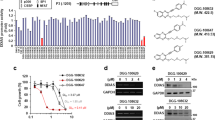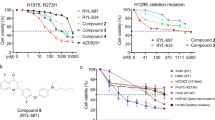Abstract
X-linked inhibitor of apoptosis (XIAP) is the most potent member of the inhibitor of apoptosis protein (IAP) gene family in terms of its ability to inhibit caspases and suppress apoptosis. Recent evidence has suggested that XIAP is a key determinant in chemoresistance of cancer cells. To explore a novel approach for ameliorating chemotherapy of gastric cancer, the antisense expression vector for the XIAP gene was constructed and transferred into gastric cancer cell lines, MKN-45 (wild-type p53) and MKN-28 (mutant-type p53). This transfer resulted in significant downregulation of XIAP expression, decreased in vitro cell viabilities, and induced apoptosis. In transferred cells, inactive caspase-3 precursors were cleaved into the active subunits (p20 and p17) during apoptosis induced by downregulation of XIAP. The inhibitory effects of cisplatin and mitomycin C on the growth of XIAP downregulated cancer cells were significantly enhanced. In addition, this process occurred only in wild-type p53 (MKN-45), but not in mutant-type p53 (MKN-28) gastric cancer cells. The data presented suggest that downregulation of XIAP via antisense RNA can lead to apoptosis of gastric cancer cells in vitro, correlating with cellular p53 status and activation of caspase-3. This finding could lead to a potential strategy for improving the efficiency of therapies for gastric cancer.
This is a preview of subscription content, access via your institution
Access options
Subscribe to this journal
Receive 12 print issues and online access
$259.00 per year
only $21.58 per issue
Buy this article
- Purchase on Springer Link
- Instant access to full article PDF
Prices may be subject to local taxes which are calculated during checkout


Similar content being viewed by others
References
Hock M, Gibson H, Korneluk RG . XIAP: apoptotic brake and promising therapeutic target. Apoptosis. 2001;6:253–261.
Notarbartolo M, Cervello M, Poma P, et al. Expression of the IAPs in multidrug resistant tumor cells. Oncol Rep. 2004;11:133–136.
Holcik M, Gibson H, Korneluk RG . XIAP: apoptotic brake and promising therapeutic target. Apoptosis. 2001;6:253–261.
Reed JC . Apoptosis-targeted therapies for cancer. Cancer Cell. 2003;3:17–22.
Hockenbery DM, Giedt CD, O'Neill JW, et al. Mitochondria and apoptosis: new therapeutic targets. Adv Cancer Res. 2002;85:203–242.
Deveraux QL, Reed JC . IAP family proteins—suppressors of apoptosis. Genes Dev. 1999;13:239–252.
Dierlamm J, Baens M, Wlodarska I, et al. The apoptosis inhibitor gene API2 and a novel 18q gene, MLT, are recurrently rearranged in the t (11;18)(q21;q21)p associated with mucosa-associated lymphoid tissue lymphomas. Blood. 1999;93:3601–3609.
Tamm I, Kornblau SM, Segall H, et al. Expression and prognostic significance of IAP-family genes in human cancers and myeloid leukemias. Clin Cancer Res. 2000;6:1796–1803.
Fong WG, Liston P, Rajcan-Separovic E, St Jean M, Craig C, Korneluk RG . Expression and genetic analysis of XIAP-associated factor 1 (XAF1) in cancer cell lines. Genomics. 2000;70:113–122.
Sasaki H, Sheng Y, Kotsuji F, Tsang BK . Down-regulation of X-linked inhibitor of apoptosis protein induces apoptosis in chemoresistant human ovarian cancer cells. Cancer Res. 2000;60:5659–5666.
Acknowledgements
We thank Dr David Vaux (Molecular Genetics of Cancer Division, The Walter and Eliza Hall Institute, Australia) for his kind gift of the XIAP gene. We also appreciate Professor Dechun Li (Johns Hopkins University School of Medicine, USA), Lauren M Tarantino, and Elizabeth M Vancza (New York University School of Medicine) for their great help in the preparation of this manuscript. This study was supported by National Natural Science Foundation of China (No. 30271301, No. 30200284) and Science Foundation of Huazhong University of Science and Technology.
Author information
Authors and Affiliations
Corresponding author
Rights and permissions
About this article
Cite this article
Tong, QS., Zheng, LD., Wang, L. et al. Downregulation of XIAP expression induces apoptosis and enhances chemotherapeutic sensitivity in human gastric cancer cells. Cancer Gene Ther 12, 509–514 (2005). https://doi.org/10.1038/sj.cgt.7700813
Received:
Published:
Issue Date:
DOI: https://doi.org/10.1038/sj.cgt.7700813
Keywords
This article is cited by
-
Abnormal activation of RFC3, A YAP1/TEAD downstream target, promotes gastric cancer progression
International Journal of Clinical Oncology (2024)
-
Curcumin inhibits cell growth and induces cell apoptosis through upregulation of miR-33b in gastric cancer
Tumor Biology (2016)
-
Mechanism of bFGF-binding Peptide Reversing Adriamycin Resistance in Human Gastric Cancer Cells
International Journal of Peptide Research and Therapeutics (2014)
-
Aspirin enhances IFN-α-induced growth inhibition and apoptosis of hepatocellular carcinoma via JAK1/STAT1 pathway
Cancer Gene Therapy (2013)
-
Expression of apoptosis-related proteins and its clinical implication in surgically resected gastric carcinoma
Virchows Archiv (2011)



